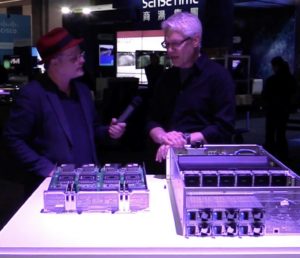 Last week at the Computex conference, Nvidia launched a partner program with hyperscale vendors Foxconn, Inventec, Quanta and Wistron to more rapidly meet the demands for AI cloud computing. Through the program, NVIDIA is providing each partner with early access to the NVIDIA HGX reference architecture, NVIDIA GPU computing technologies, and design guidelines. HGX is the same data center design used in Microsoft’s Project Olympus initiative, Facebook’s Big Basin systems and NVIDIA DGX-1 AI supercomputers.
Last week at the Computex conference, Nvidia launched a partner program with hyperscale vendors Foxconn, Inventec, Quanta and Wistron to more rapidly meet the demands for AI cloud computing. Through the program, NVIDIA is providing each partner with early access to the NVIDIA HGX reference architecture, NVIDIA GPU computing technologies, and design guidelines. HGX is the same data center design used in Microsoft’s Project Olympus initiative, Facebook’s Big Basin systems and NVIDIA DGX-1 AI supercomputers.
Accelerated computing is evolving rapidly — in just one year we tripled the deep learning performance in our Tesla GPUs — and this is having a significant impact on the way systems are designed,” said Ian Buck, general manager of Accelerated Computing at NVIDIA. “Through our HGX partner program, device makers can ensure they’re offering the latest AI technologies to the growing community of cloud computing providers.”
Using HGX as a starter “recipe,” ODM partners can work with NVIDIA to more quickly design and bring to market a wide range of qualified GPU-accelerated systems for hyperscale data centers. Through the program, NVIDIA engineers will work closely with ODMs to help minimize the amount of time from design win to production deployments.
As the overall demand for AI computing resources has risen sharply over the past year, so has the market adoption and performance of NVIDIA’s GPU computing platform. Today, 10 of the world’s top 10 hyperscale businesses are using NVIDIA GPU accelerators in their data centers.
With new NVIDIA Volta architecture-based GPUs offering three times the performance of its predecessor, ODMs can feed the market demand with new products based on the latest NVIDIA technology available.
Flexible, Upgradable Design
NVIDIA built the HGX reference design to meet the high-performance, efficiency and massive scaling requirements unique to hyperscale cloud environments. Highly configurable based on workload needs, HGX can easily combine GPUs and CPUs in a number of ways for high performance computing, deep learning training and deep learning inferencing.
The standard HGX design architecture includes eight NVIDIA Tesla GPU accelerators in the SXM2 form factor and connected in a cube mesh using NVIDIA NVLink high-speed interconnects and optimized PCIe topologies. With a modular design, HGX enclosures are suited for deployment in existing data center racks across the globe, using hyperscale CPU nodes as needed.
We’ve collaborated with Ingrasys and NVIDIA to pioneer a new industry standard design to meet the growing demands of the new AI era,” said Kushagra Vaid, general manager and distinguished engineer, Azure Hardware Infrastructure, Microsoft Corp. “The HGX-1 AI accelerator has been developed as a component of Microsoft’s Project Olympus to achieve extreme performance scalability through the option for high-bandwidth interconnectivity for up to 32 GPUs.”
Both NVIDIA Tesla P100 and V100 GPU accelerators are compatible with HGX. This allows for immediate upgrades of all HGX-based products once V100 GPUs become available later this year.
In this video from the 2017 GPU Technology Conference, Rob Ober from Nvidia describes the new HGX-1 reference platform for GPU computing.
HGX is an ideal reference architecture for cloud providers seeking to host the new NVIDIA GPU Cloud platform. The NVIDIA GPU Cloud platform manages a catalog of fully integrated and optimized deep learning framework containers, including Caffe2, Cognitive Toolkit, MXNet and TensorFlow.
Through this new partner program with NVIDIA, we will be able to more quickly serve the growing demands of our customers, many of whom manage some of the largest data centers in the world,” said Taiyu Chou, general manager of Foxconn/Hon Hai Precision Ind Co., Ltd., and president of Ingrasys Technology Inc. “Early access to NVIDIA GPU technologies and design guidelines will help us more rapidly introduce innovative products for our customers’ growing AI computing needs.”




